AKAI AFX
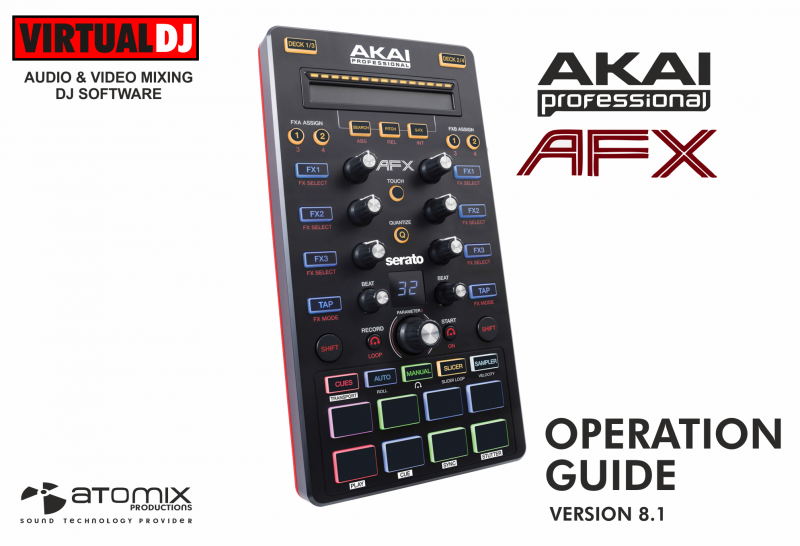
SETUP
Firmware: No firmware update is available at the time that this guide is written, but you should always check the product’s webpage http://www.akaipro.com/product/afx#downloads
Drivers: No driver software is required for the AKAI AFX to be installed. The device is a USB class compliant and your Operating System will auto-install the necessary driver when connected with a USB cable.
VirtualDJ 8 Setup
Once VirtualDJ is launched, a Connect Window will appear. Login with your virtualdj.com account credentials. A Pro Infinity, an AFX Home Plus or a Pro Subscription License is required to fully use the AKAI AFX.
Without any of the above Licenses, the controller will operate for 10 minutes each time you restart VirtualDJ.
http://www.virtualdj.com/buy/index.html
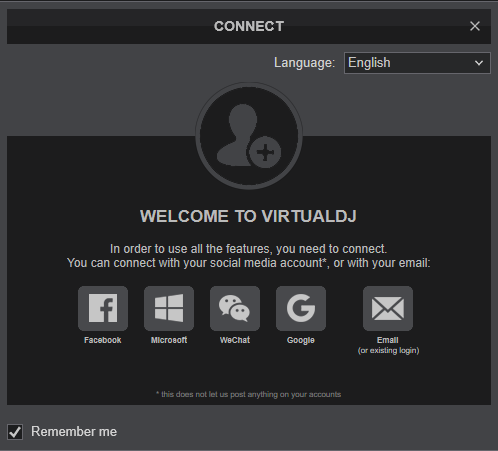
Click to OK.
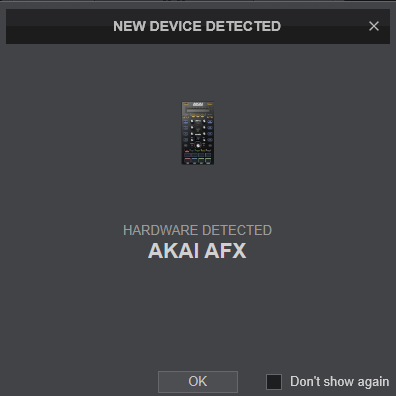
The unit is now ready to operate.
MIDI Operation
The unit should be visible in the MAPPING tab of VirtualDJ Settings and the “factory default” available/selected from the Mappings drop-down list. The factory default Mapping offers the functions described in this Manual, however those can be adjusted to your needs via VDJ Script actions.

Find more details at http://www.virtualdj.com/wiki/VDJ8script.html
Audio Setup
The unit is not offering any pre-defined audio configuration, as no built-in audio interface is available. Depending on the sound card you need to use, manually create the necessary Master and Headphones audio configuration.
By default VirtualDJ 8 will send the Master Output to the built-in (default) sound card of your computer.
See Audio setup examples in VirtualDJ Manual https://www.virtualdj.com/manuals/virtualdj/settings/audiosetup.html
For further software settings please refer to the User Guide of VirtualDJ. http://www.virtualdj.com/manuals/virtualdj8/index.html
CONTROLS
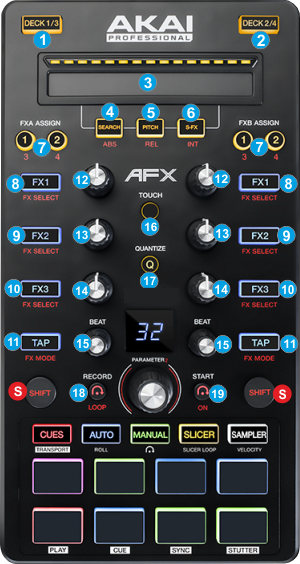
- S. SHIFT. Press and hold any of these buttons down to access secondary functions of the AKAI AFX
- DECK 1/3 SELECT. Use this button to assign the unit to deck* (layer) 1 or 3. The button will light orange if deck 1 is selected, red if deck 3 is selected and will be off if a different deck is selected.
- DECK 2/4 SELECT. Use this button to assign the unit to deck* (layer) 2 or 4. The button will light orange if deck 2 is selected, red if deck 4 is selected and will be off if a different deck is selected.
*Note that the DECK button only assigns the controller to a hardware layer and cannot be used to assign any software deck as left or right.
The assigned deck will apply to all the functions of the unit except from the FX section. - TOUCH STRIP. The touch strip offers different functionality depending on the selected mode (using the Touch Mode buttons 4, 5 and 6).
In Search mode use the touch strip to navigate (seek) through the loaded track of the assigned deck.
Hold SHIFT down and then use the Touch Strip to fine-position or Scratch,Touch Strip.
In Pitch mode touch the Touch Strip anywhere from the middle point to the far right side to temporary speed-up the tempo of the track (Pitch Bend). Touch anywhere from the middle points to the far left side to temporary slow-down the tempo of the track (Pitch Bend). Once released, the tempo will return to the value designated by the pitch fader.
Hold SHIFT down and then use the Touch Strip to adjust the tempo (pitch) of the track - SEARCH. Press this button to set the Touch Strip to Search mode. Hold SHIFT down and then press this button to set the Timecode mode to Absolute (for DVS)
- PITCH. Press this button to set the Touch Strip to Pitch mode. Hold SHIFT down and then press this button to set the Timecode mode to Relative (for DVS)
- S-FX. Press this button to set the Touch Strip to FX mode. Hold SHIFT down and then press this button to set the Timecode mode to Smart (for DVS)
Global
- TOUCH. Use this button to enable the Touch mode. When enabled, the FX knobs will offer additional functions when touched.
- QUANTIZE. Use this button to enable/disable Smart Cue to all 4 decks. When Smart Cue is enabled the HotCues will snap to the nearest beat (or smaller size depending on the SmartCueQuantize setting)
- RECORD. Use this button to start/stop recording your mix. Hold SHIFT down and then use this button to start/stop recording Master to a new Sample (led will blink while recording)
- START. Use this button to enable/disable Automix*. Hold SHIFT down and then use this button to enable/disable Sandbox*.
*Read VirtualDJ User Guide for further details on Automix and Sandbox. - PARAMETER ENC (& LCD display). The encoder offers various functions depending on the selected PAD mode (see PADS).
- PAD MODE SEL. Use these buttons to set the PADS (22) to one of the 9 available Pad modes (see PADS)
- PADS. The 8 touch-sensitive Pads offer different functionality, depending on the selected Pad mode. (see PADS )
The Pads offer touch velocity in all modes (pre-assigned only in the Sampler Velocity mode) and RGB leds.
EFFECTS
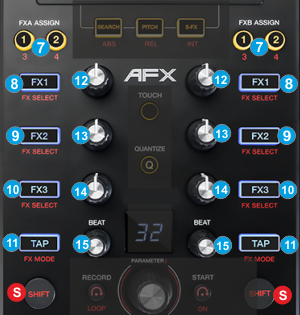 The AKAI AFX offers 2 Effects units (FXA/FXB) to control the Effects of the left/right decks
The AKAI AFX offers 2 Effects units (FXA/FXB) to control the Effects of the left/right decks Each unit can be set to 2 modes (Single and Multi). In Single Effect mode, each unit offers controls for a single Effect slot (with the most available parameters) and in Multi Effects mode each unit offers controls for 3 Effect slots (but with less parameter controls).
- FX A/B ASSIGN. Use these buttons to clone the selected Effects from one deck to the other. E.g. pressing the FX2 ASSIGN button on the FXA unit, will clone the Effects from Deck 2 to the Left assigned deck.
- FX1 button
Single FX Mode. Press this button to trigger the selected Effect. Hold SHIFT down and then press this button to select the next Effect.
Multi FX Mode. Press this button to trigger the selected Effect on FX Slot 1. Hold SHIFT down and then press this button to select the next Effect for FX Slot 1. - FX2 button
Single FX Mode. Use this button to control the Effect button 1 of the selected Effect (if the Effect offers one). In this mode the led will light red if the Effect button is enabled.
Multi FX Mode. Press this button to trigger the selected Effect on FX Slot 2. Hold SHIFT down and then press this button to select the next Effect for FX Slot 2. - FX3 button
Single FX Mode. Use this button to control the Effect button 2 of the selected Effect (if the Effect offers one). In this mode the led will light red if the Effect button is enabled.
Multi FX Mode. Press this button to trigger the selected Effect on FX Slot 3. Hold SHIFT down and then press this button to select the next Effect for FX Slot 3. - TAP. Use this button (tap on beat) to manually define the tempo of the track loaded to the assigned deck (or the left/right deck if no deck is assigned from the FXA/FXA buttons)
Hold SHIFT down and then press this button to toggle between the Single and Multi FX modes (the corresponding panels on the Default 4 Decks GUI of VirtualDJ will follow the selection). - FX1 KNOB.
Single FX Mode. The knob controls the 1st parameter of the selected Effect. Hold SHIFT down and then use this knob to control the 4th parameter of the selected Effect.
Multi-FX Mode: The knobs control the 1st parameter of the selected Effect on FX Slot 1. Hold SHIFT down and then use this knob to control the 2nd parameter of the selected Effect on FX Slot 1.
If the Touch Mode (16) is activated, touch the FX1 Knob to activate its assigned effect, and release the knob to deactivate it - FX2 KNOB.
Single FX Mode. The knob controls the 2nd parameter of the selected Effect. Hold SHIFT down and then use this knob to control the 5th parameter of the selected Effect.
Multi-FX Mode: The knobs control the 1st parameter of the selected Effect on FX Slot 2. Hold SHIFT down and then use this knob to control the 2nd parameter of the selected Effect on FX Slot 2.
If the Touch Mode (16) is activated, touch the FX2 Knob to activate its assigned effect, and release the knob to deactivate it - FX3 KNOB.
Single FX Mode. The knob controls the 3rd parameter of the selected Effect. Hold SHIFT down and then use this knob to control the 6th parameter of the selected Effect.
Multi-FX Mode: The knobs control the 1st parameter of the selected Effect on FX Slot 3. Hold SHIFT down and then use this knob to control the 2nd parameter of the selected Effect on FX Slot 3.
If the Touch Mode (16) is activated, touch the FX3 Knob to activate its assigned effect, and release the knob to deactivate it - BEAT. Use this encoder to adjust the Beats of the selected effect (not all Effects offer a Beats parameter).
Hold SHIFT down and then use this encoder to move the position of the track forward/backwards by 1 beat.
PADS
Pads (22) offer 10 different modes, depending on the PAD MODE SEL buttons (21). press the 5 PAD MODE buttons to select the Hotcues, Auto Loop, Manual Loop, Slicer and Sampler modes respectively. While one of the main modes is selected, press the same PAD MODE button again to access the additional Transport, Loop Roll, Saved Loops, Beatjump and Sampler Velocity modes (the LED will blink as an indication). The Pads are assigned to control the PADS section of the VirtualDJ 8 default skins and each time a mode is selected from the AFX the respective PADS page will be auto-selected on the VirtualDJ GUI.
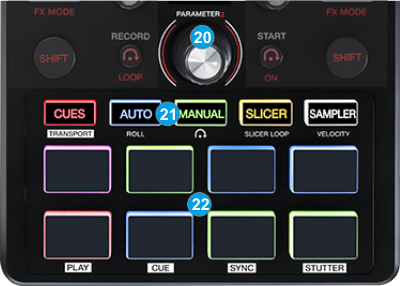
PADS - HOTCUES
Press the CUES mode button to set the PADs to HotCue mode. The PADS section of the default VirtualDJ GUI will be automatically set to the Hotcues page.

Each one of the 8 pads assigns a Hot Cue Point (1 to 8) or jumps the track to that Hot Cue Point if assigned.
When a Hot Cue Button is unlit (empty), you can assign a Hot Cue Point by pressing it at the desired point in your track. Once it is assigned, the Hot Cue Button will light up. The color that the LED will get, depends on the nonColoredPOI setting of VIrtualDJ. By default, the LEDs will get the color of the deck (blue for deck 1, red for deck 2 etc)
Hold SHIFT and then press any of the pads to delete its assigned Hot Cue Point.

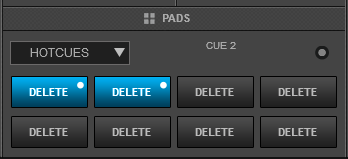
Use the PARAMETER Encoder (20) to double/half the size of a Loop. Push the encoder to trigger the selected loop.
The LCD display will indicate the selected loop size in beats. The dot displayed after the digits indicates that the selected loop size is 1/x beats.
Hold SHIFT and then turn the encoder to move the track forward/backwards by 1 beat
PADS - TRANSPORT
While the Hot Cue mode is selected, press the same CUES mode button again to set the PADs to Transport mode (led will blink). The Pads section of the default VirtualDJ GUI on the corresponding deck will be also set to a special Transport pad page.
The Transport mode is selected by default on first launch (for all decks) and offers 4 HotCues and transport deck controls

Each one of the 4 pads at the top row assigns a Hot Cue Point (1 to 4) or returns the track to that Hot Cue Point.
When a Hot Cue Button is unlit, you can assign a Hot Cue Point by pressing it at the desired point in your track. Once it is assigned, the Hot Cue Button will light up. The color that the LED will get, depends on the nonColoredPOI setting of VIrtualDJ. By default, the LEDs will get the color of the deck (blue for deck 1, red for deck 2 etc)
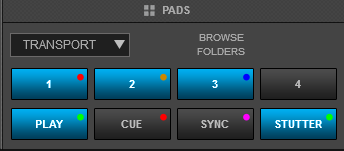

Hold SHIFT and then press any of the 4 pads to delete its assigned Hot Cue Point.
Use the 1st Pad of the bottom row to play-pause the track. Hold SHIFT down and then use the same pad to play the track in reverse.
The 2nd pad of the bottom row offers CUE function.
When the Deck is paused, you can set a Temporary Cue Point by moving the Platter to place the Audio Pointer at the desired location and then pressing this pad.
During playback, you can press the Cue Pad to return the track to this Cue Point. (If you did not set a Cue Point, then it will return to the beginning of the track.).
If the Deck is paused, you can press and hold the Cue Pad to play the track from the Temporary Cue Point. Releasing the Cue Pad will return the track to the temporary Cue Point and pause it. To continue playback without returning to the Temporary Cue Point, press and hold the Cue Pad, then press and hold the Play Pad, and then release both buttons
Use the 3rd Pad (SYNC) to automatically match the corresponding Deck's tempo with the opposite Deck's (or the Master Deck’s if using a 4 decks Skin) tempo and phase.
Press and hold SHIFT and press this pad to set this deck as Master Deck (for 4 decks skins - all other decks will sync to the Master Deck is SYNC is pressed on those decks).
Use the 4th Pad (STUTTER) to play-stutter the track. Each time the pad is pressed, the track will jump to the last paused point and will continue to play from that point.
Use the PARAMETER (20) encoder to scroll through files or folders. Hold SHIFT down and then use the encoder to cycle through the available Browser windows.
Push the encoder to load the selected track to the assigned deck or move to the Songs List if focus is to the Folders List.
Hold SHIFT down and then push the encoder to open/close subfolders.
The LCD display in this mode will still will indicate the selected loop size in beats.
PADS - AUTO LOOP
Press the AUTO mode button to set the Pads to Auto Loop mode. The PADS section of the default VirtualDJ GUI will be automatically set to the Loop page.


Each one of the 8 Pads triggers a Loop of a different size in beats, depending on the selected Page, starting from 1/32 of a beat up to 128 beats.
Use the PARAMETER (20) encoder to select a page with the desired loop lengths.
Hold SHIFT down and then use the encoder to select the mode for the triggered loops. Hold (while pressed), On/off (toggle) or Roll (track will resume to the position it would have been if the loop was never applied) can be selected.
Push the encoder to enable/disable the selected loop size.
The LCD display will indicate the selected loop size in beats. The dot displayed after the digits indicates that the selected loop size is 1/x beats.
PADS - LOOP ROLL
While the Auto Loop mode is selected, press the same AUTO mode button again to set the PADs to Loop Roll mode (led will blink). The Pads section of the default VirtualDJ GUI on the corresponding deck will be also set to the Loop Roll pad page.

Each one of the 8 Pad triggers a momentary Loop Roll (while pressed) of a size as shown in the image above. Once the Pad is released, the track will resume playing from the position it would have been, if the Loop was never triggered.
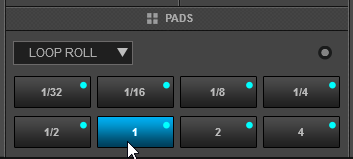
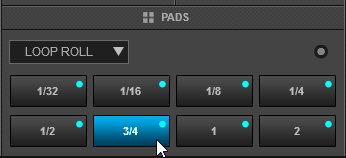
Hold SHIFT to access a secondary Loop Roll page with 3/4, 1 and 2 beats instead of 1, 2 and 4 for the last 3 Pads, as per the image above.
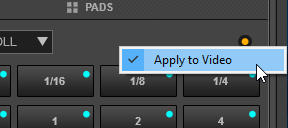
In this mode the PARAMETER (20) encoder controls and trigger normal loops.
The LCD display will indicate the size of the applied Loop Roll when triggered and the size of the selected Loop if no Loop Roll is triggered.
The dot displayed after the digits indicates that the selected loop size is 1/x beats.
PADS - MANUAL LOOP
Press the MANUAL mode button to set the Pads to Manual Loop mode. The Pads section of the default VirtualDJ GUI on the corresponding deck will be also set to the Manual Loop pad page.

Each one of the 8 pads offers a different loop function.
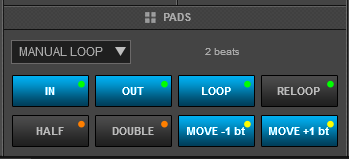
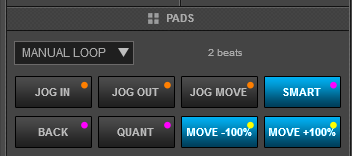
Pad 1 sets the current track's position as the Entry point of a Loop (Loop In). If a Loop is triggered, the same button will jump the track to the Loop In point each time is pressed.
While a loop is active, hold SHIFT down and then use this button to set the Jogwheel to Loop In Adjust mode and fine adjust the Loop In point using a jogwheel (of a controller or even from the skin).
Pad 2 sets the current track's position as the Exit point of a Loop (Loop Out) and enables the manual loop. If a Loop is triggered, the same button will exit the Loop.
While a loop is active, hold SHIFT down and then use this button to set the Jogwheel to Loop Out Adjust mode and fine adjust the Loop Out point using a jogwheel (of a controller or even from the skin).
Pad 3 enables/disables a Loop of the selected size in beats.
While a loop is active, hold SHIFT down and then use this button to set the Jogwheel to Loop Move Adjust mode and fine move the Loop through the track using a jogwheel (of a controller or even from the skin).
Pad 4 - Reloop. Will enable the last triggered loop (will jump to its Loop In position).
Hold SHIFT down and then use this Pad to enable/disable Smart Loop mode. When enabled, manual loops will be auto-adjusted to the nearest size, to provide a seamless loop.
Pad 5 halves the size of the Loop in beats.
Hold SHIFT to enable/disable the Loop Back mode. When this mode is enabled, the current track's position will be the Exit point of an Auto Loop.
Pad 6 doubles the size of the Loop in beats.
Hold SHIFT and then use this pad to enable/disable the Quantize Loop mode. When enabled, loops will be snapped to the nearest beat.
Pad 7 will move the triggered loop backwards by 1 beat
Hold SHIFT to move the the triggered loop backwards by the same size in beats as the loop
Pad 8 will move the triggered loop forward by 1 beat
Hold SHIFT to move the the triggered loop forward by the same size in beats as the loop
The PARAMETER (20) encoder will control the size (half/double) and trigger the selected loop if pushed.
The LCD display will indicate the size the selected Loop in beats.
PADS - SAVED LOOPS
While the Manual Loop mode is selected, press the same MANUAL mode button again to set the PADs to Saved Loops mode (led will blink). The Pads section of the default VirtualDJ GUI on the corresponding deck will be also set to the Saved Loops pad page.

Each pad offers the ability to store and trigger a Saved Loop. Up to 8 Loops can be stored, but only 1 can be enabled/triggered. Press a pad to store (and enable) a loop of the currently selected size in beats at the current track's position. If a slot is stored/saved, press the same Pad to load and prepare the loop but not jump to its position if its later to the current.
Hold the same Pad for more then 1 second to delete the stored loop.
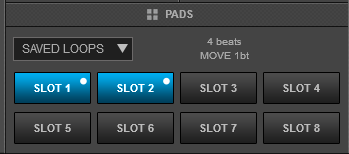
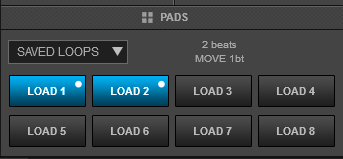
Hold SHIFT and then use the same Pad to load the same Loop but also jump to its position.
The LEDs of the Saved Loops Pads will be turned on white by default. Custom colors can be selected from the POI Editor.
The PARAMETER (20) encoder will control the size (half/double) and trigger the selected loop if pushed. Hold SHIFT and then use the encoder to move the loop forward/backwards by 1 beat
The LCD display will indicate the size the selected Loop in beats.
PADS - SLICER
Press the SLICER mode button to set the PADs to Slicer mode. The Pads section of the default VirtualDJ GUI on the corresponding deck will be also set to the Slicer pad page.
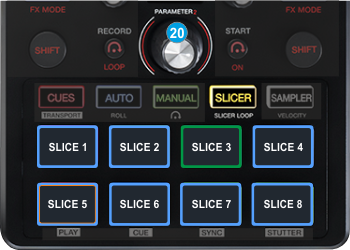
The 8 Pads represent 8 sequential slices in the Beat Grid. The playing Slice is represented by the currently blue lit pad. The green light will "move through the pads" as it progresses through each eight-Slice phrase. Press a pad to repeat that Slice (hold it down if you want to keep looping it).
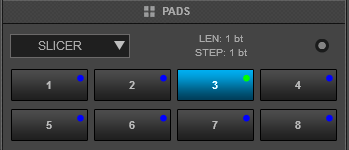
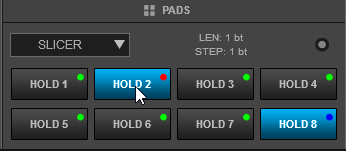
Once the Pad is released the track will continue to play from the position it would have been if the pad was never pressed.
Hold SHIFT down to repeat the last/memorized slice.
The PARAMETER (20) encoder will increase/decrease the length of the applied loop on the slice
Hold SHIFT down and then use the same PARAMETER encoder to increase/decrease the step of the Slicer (size of slice in beats).
The LCD will display the selected loop size in this mode and pressing the PARAMETER encoder will trigger the selected loop..
PADS - BEAT JUMP
While the Slicer mode is selected, press the SLICER mode button again to set the PADs to Beatjump mode (led will blink). The Pads section of the default VirtualDJ GUI on the corresponding deck will be also set to the Beajump pad page.
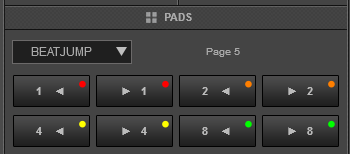
The Pads move the track forward or backwards by the amount of beats specified (from 1/16 of a beat up to 32 Bars) depending on the selected page.
Use the PARAMETER (20) encoder to select one of the 9 available pages for the Beatjump mode.
PADS - SAMPLER
Press the SAMPLER mode button to set the PADs to Sampler mode. The Pads section of the default VirtualDJ GUI on the corresponding deck will be also set to the Sampler pad page.
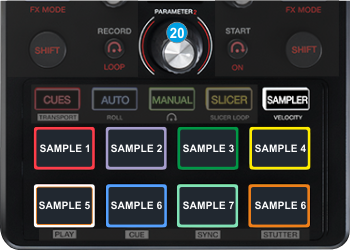
Each one of the 8 pads triggers a sample (1 to 8) from the selected Sampler Bank of VirtualDJ.
The leds of the Pads will automatically get the assigned color of each sample (dark when off, bright when playing).
Press the pads to trigger a sample. Depending on the selected trigger mode, use SHIFT and the same pads to stop the sample.
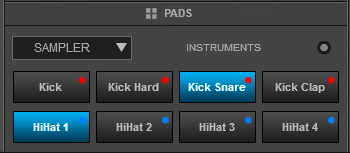
Use the PARAMETER (20) encoder to select the previous or next Sampler Bank.
Hold SHIFT and then use the encoder to cycle through the available trigger modes (On/Off, Hold, Stutter and Unmute).
Sampler Velocity mode
While the Sampler mode is selected, press the same SAMPLER mode button again to set the PADs to Sampler Velocity mode (led will blink).The Pads section of the default VirtualDJ GUI on the corresponding deck will still be set to the Sampler pad page.
Exactly as in the Sampler mode, each one of the 8 pads triggers a sample (1 to 8) from the selected Sampler Bank of VirtualDJ, with the difference that the Output Volume of each sample is determined by the strength the Pad was initially pressed.
Press the pads to trigger a sample. Depending on the selected trigger mode, use SHIFT and the same pads to stop the sample.
The functionality of the PARAMETER encoder (20) is the same as in the Sampler mode.
